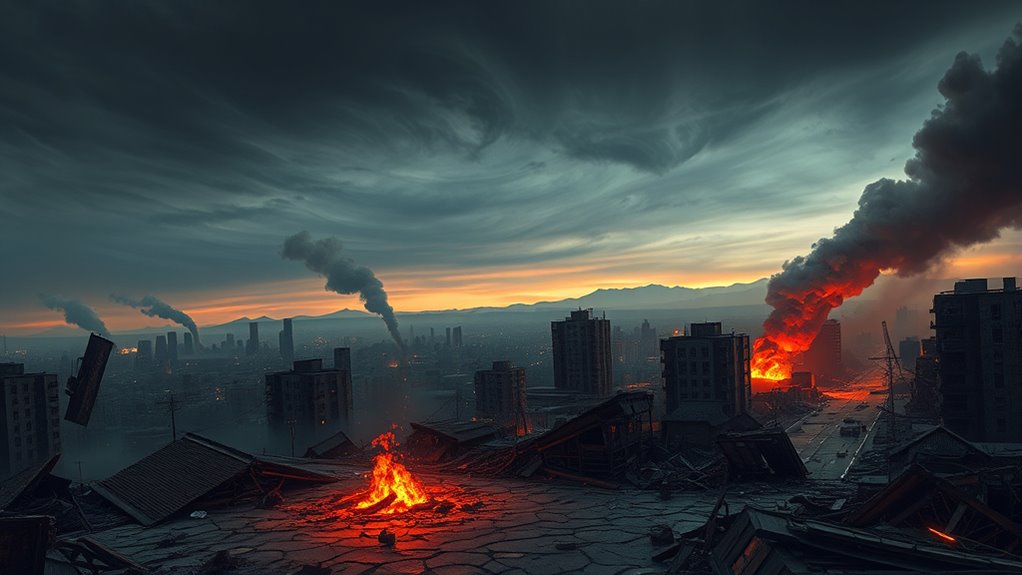Armageddon refers to a final, epic battle between good and evil, rooted in religious texts like the Bible and other cultural myths, symbolizing judgment and renewal. While some see it as a literal location, many interpret it as a spiritual or symbolic event rather than a specific place. Its meaning blends history, prophecy, and myth. To discover how different perspectives shape this concept and where it might be, stay with us for more insights.
Key Takeaways
- “Armageddon” traditionally refers to the final, decisive battle between good and evil, symbolizing ultimate destruction and renewal.
- In biblical context, it is associated with the Valley of Megiddo in Israel, where the climactic battle is believed to occur.
- Spiritually, “Armageddon” signifies cosmic or spiritual confrontation beyond a specific geographic location.
- Cultural and mythological interpretations depict it as a mythic struggle representing chaos versus order.
- Scientific and modern perspectives view “Armageddon” as a metaphor for global crises, not a physical place or event.
The Origins and Historical Context of Armageddon

The concept of Armageddon has deep roots that trace back to ancient times, shaping how societies envisioned catastrophic end-of-days scenarios. Ancient texts often depict this as a final, decisive confrontation, filled with mythical battles between good and evil. These stories serve as allegories for chaos and divine judgment, influencing many cultures’ beliefs about the world’s end. In these texts, Armageddon isn’t just a physical location but a symbol of ultimate destruction and renewal. Mythical battles are central to these narratives, representing the struggle between forces of order and chaos. Over centuries, these stories evolved, blending myth with prophecy, and laying the groundwork for later religious interpretations. Understanding this historical context helps you see how ancient fears and hopes shaped the enduring idea of Armageddon.
Religious Perspectives and Prophecies
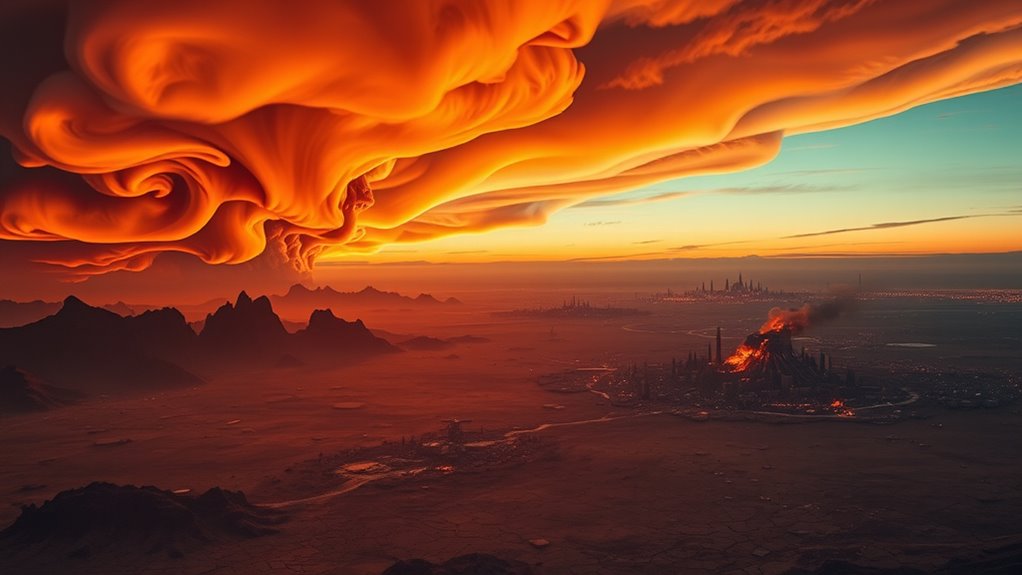
Have you ever wondered how different religions interpret the idea of Armageddon? Many see it as a divine showdown where good confronts evil, often linked to end-times prophecies. Some believe climate change signals this impending event, viewing environmental collapse as a form of divine punishment. Others focus on a technological apocalypse, where artificial intelligence or nuclear war triggers chaos. Here’s a quick look at diverse perspectives:
| Religion | Prophetic Focus | Key Event |
|---|---|---|
| Christianity | Second Coming of Christ | Final battle leading to judgment |
| Islam | Day of Resurrection | Destruction followed by divine judgment |
| Judaism | Messianic Age | Gathering of nations, divine intervention |
These views shape how followers interpret the signs of an approaching end.
Mythical and Cultural Interpretations
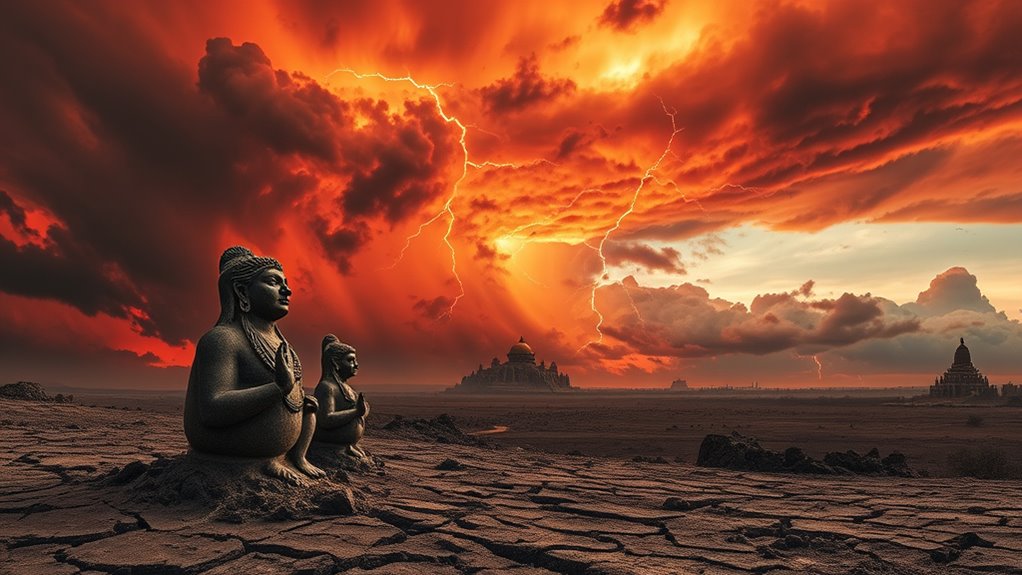
Ever wondered how myths and legends shape our understanding of apocalyptic events? Throughout history, mythical creatures like dragons and giants symbolize chaos and destruction, reflecting humanity’s fears of end-times. Cultural festivals often reenact these stories, serving as collective rituals to confront fears and seek renewal. For example, some societies celebrate fire festivals or monster parades that symbolize battling evil forces, reinforcing cultural beliefs about the apocalypse. These stories and traditions help us interpret apocalyptic themes beyond religious texts, embedding them into shared history and identity. They shape our perception of destruction as both a destructive force and a path to rebirth. Mythical and cultural interpretations therefore offer a rich, symbolic lens through which to understand humanity’s enduring fascination with the end of the world.
Scientific and Astronomical Theories
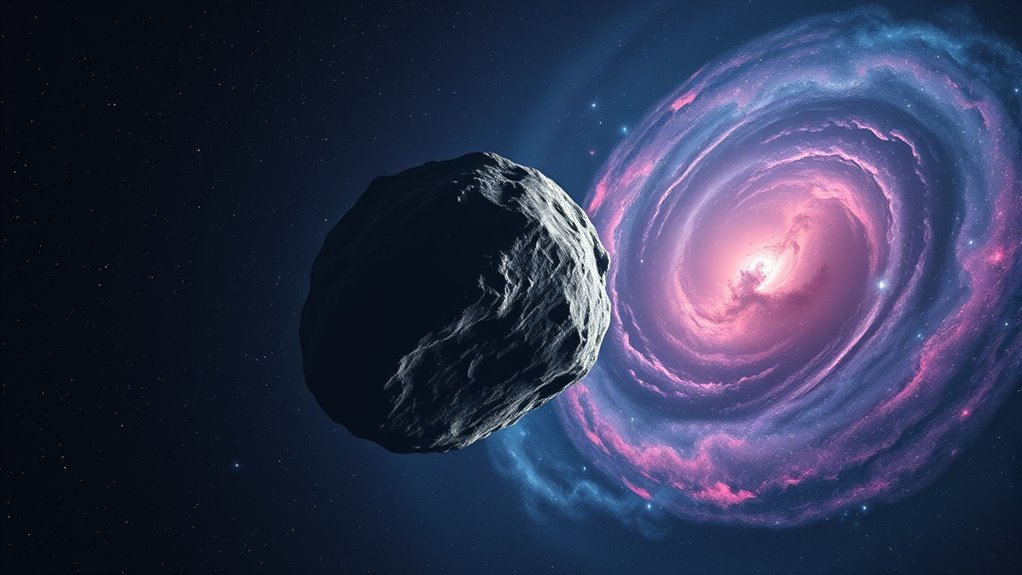
Scientists predict potential cosmic impacts that could threaten Earth, emphasizing the importance of understanding celestial movements. You’ll learn how astronomers trace the origins of asteroids and comets, revealing their journeys through space. These theories help us assess the risks and prepare for possible future threats from the cosmos.
Cosmic Impact Predictions
How do astronomers predict potential cosmic impacts, and what scientific theories underpin these forecasts? They monitor objects in deep space, focusing on near-Earth objects like asteroids and comets. Using telescopes and advanced tracking systems, they measure orbits and velocities to identify possible planetary collisions. Scientific models, based on gravitational physics and celestial mechanics, help forecast future paths. These theories consider how gravitational influences from planets and other bodies alter trajectories over time. By analyzing this data, astronomers assess impact probabilities and potential threat levels. Continuous observations and simulations refine these predictions, enabling early warnings. This approach relies on understanding the dynamics of deep space objects and applying fundamental principles of physics to anticipate and potentially prevent catastrophic planetary collisions.
Celestial Body Origins
Understanding the origins of celestial bodies deepens our grasp of the universe’s history and evolution. Scientific and astronomical theories suggest that many celestial bodies formed through processes like asteroid collisions and planetary alignment. When asteroid collisions occur, debris from space clumps together over millions of years, creating new planets or moons. Planetary alignment, where planets line up in specific arrangements, influences gravitational forces that can trigger these collisions or shape celestial evolution. These events help explain how planets, asteroids, and comets came into existence. By studying these mechanisms, you gain insight into the dynamic forces that sculpt our cosmic environment. Recognizing the role of asteroid collisions and planetary alignment allows you to appreciate the complexity behind the formation and distribution of celestial bodies in our universe.
The Symbolism Behind the Term
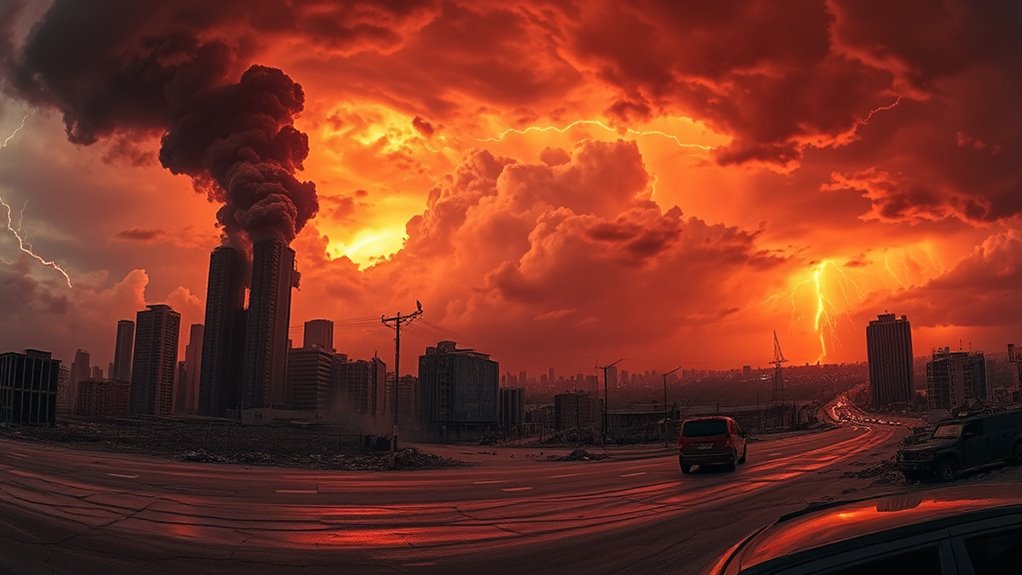
What makes the term “Armageddon” so powerful is its rich symbolism rooted in biblical tradition. It evokes apocalyptic symbolism that signifies the ultimate clash between good and evil. The term is heavily associated with end times imagery, portraying a final, decisive battle where chaos and destruction unfold. This imagery amplifies its meaning, suggesting a cataclysmic event that marks the conclusion of the world as we understand it. The biblical references to Armageddon emphasize themes of divine judgment, moral reckoning, and the triumph of righteousness over darkness. Its symbolism taps into deep-seated fears and hopes about humanity’s final destiny, making it a potent metaphor for total upheaval and the end of an era.
Modern-Day Conceptions and Media Portrayals
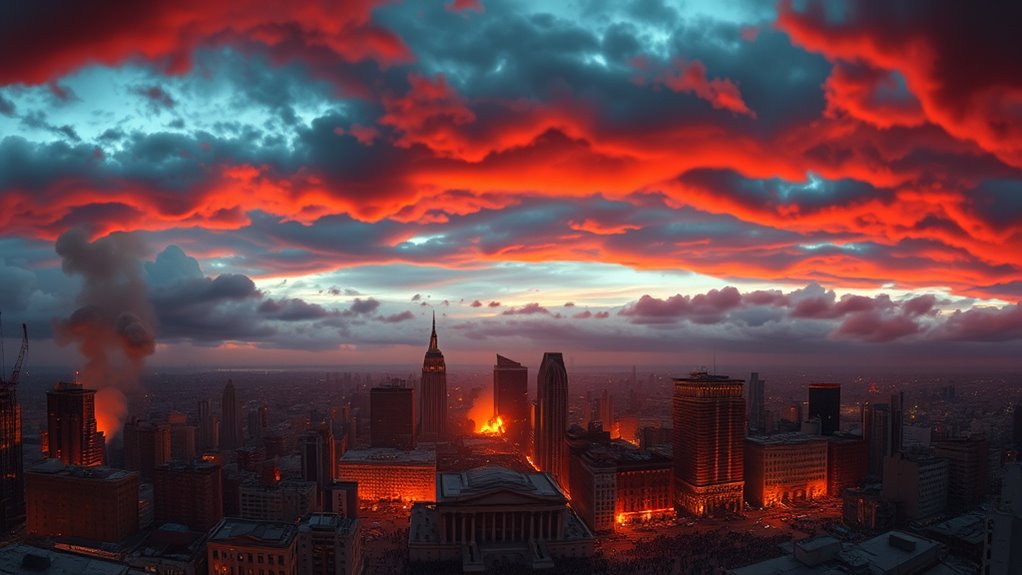
You see how movies and TV shows often depict apocalyptic events as grand, dramatic battles or natural disasters. These portrayals shape your understanding of what an end-times scenario might look like. Today, many people also hold modern beliefs about doomsday, influenced by media stories and cultural trends.
Popular Media Depictions
Modern media often depicts Armageddon as a dramatic, often cinematic event that signals the end of the world. Films and TV shows frequently portray planetary collision scenarios, emphasizing massive cosmic disasters that wipe out humanity. These depictions draw heavily from end of days myths, blending religious themes with sci-fi spectacle. You might see giant asteroids hurtling toward Earth or planets colliding in spectacular displays, emphasizing the chaos and destruction that could mark humanity’s final moments. Such portrayals tap into deep-seated fears of cosmic annihilation, exaggerating the threat for dramatic effect. While these scenarios make for gripping stories, they tend to oversimplify or sensationalize the actual scientific understanding of planetary threats, creating a vivid but often exaggerated image of what Armageddon truly entails.
Contemporary Doomsday Beliefs
Have contemporary fears of global catastrophe been shaped more by media or by real scientific concerns? Many believe media exaggerates threats like nuclear warfare and environmental collapse, fueling panic. In reality, scientists warn that risks are real but manageable with proper action. Media often sensationalizes issues, leading to heightened anxiety. To understand the scope, consider this table:
| Threat | Media Portrayal | Scientific Consensus |
|---|---|---|
| Nuclear Warfare | Apocalyptic, immediate doom | Risk exists but deterrence works |
| Environmental Collapse | Overhyped catastrophe | Urgent, but solutions are possible |
| Global Pandemics | Doomsday scenarios | Preparedness can mitigate risks |
While media amplifies fears, scientific concerns highlight the importance of awareness and proactive measures.
Is There a Real Location or Just a Symbolic Site?
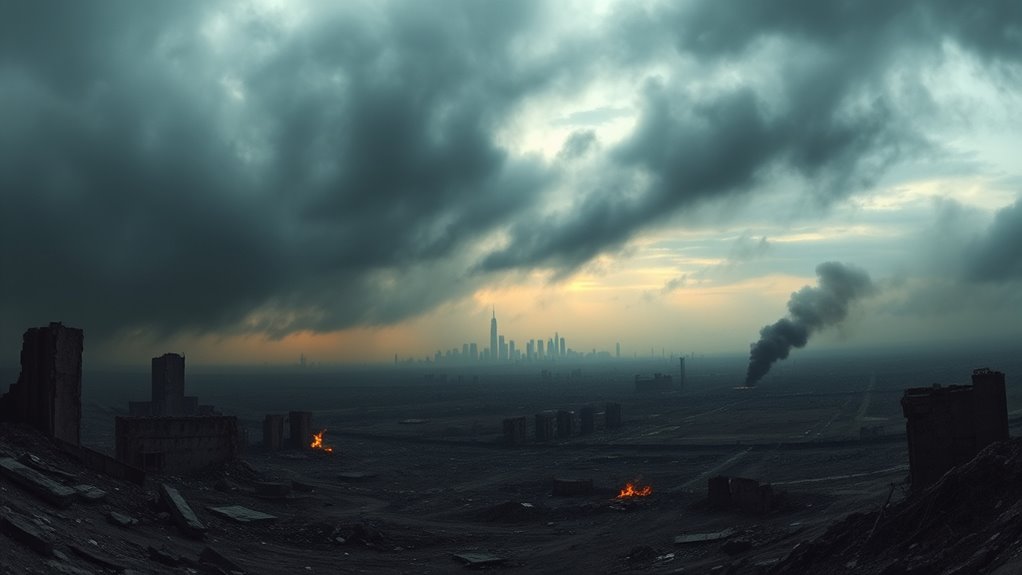
Many scholars and theologians debate whether the biblical Armageddon points to a specific, real location or simply serves as a symbolic site representing the ultimate battle between good and evil. Some argue that geographical myths have shaped the idea of a precise site, like the Valley of Megiddo in Israel, giving it historical grounding. Others believe that Armageddon is better understood through symbolic interpretations, representing a cosmic struggle rather than a physical place. These symbolic views emphasize the spiritual significance over geographical accuracy. Ultimately, whether you see Armageddon as a literal location or a metaphorical concept depends on your interpretive approach. The debate continues, blending historical myths with spiritual symbolism in ways that challenge straightforward geographic identification.
Frequently Asked Questions
How Has the Concept of Armageddon Influenced Modern Geopolitics?
You see, the idea of Armageddon influences modern geopolitics by fueling fears of nuclear proliferation and religious extremism. Leaders often cite these concepts to justify military actions or build alliances, aiming to prevent catastrophic conflicts. This mindset shapes policies, encouraging nuclear arsenals as deterrents and fostering tensions with extremist groups. Ultimately, the threat of global destruction keeps nations cautious, but it also risks escalating conflicts rooted in these apocalyptic fears.
Are There Any Archaeological Sites Linked to the Biblical Armageddon?
Imagine uncovering ancient ruins that whisper secrets of prophecy. You’ll find archaeological discoveries in places like Megiddo in Israel, often linked to biblical Armageddon. These sites, rich with history, may not definitively confirm the biblical battle, but they fuel curiosity and faith. Archaeologists continue exploring, seeking clues in ancient artifacts and layered ruins, making the quest for understanding both a journey through time and a search for divine truth.
What Are the Psychological Impacts of Armageddon Fears on Society?
You might feel psychological anxiety and societal paranoia when fears of an impending catastrophe rise. These feelings can lead to increased stress, mistrust, and even social withdrawal. As you witness heightened alarm, you could notice communities becoming more suspicious and less cooperative. This collective panic impacts mental health and social cohesion, making it harder to address real issues calmly and rationally, ultimately fueling a cycle of fear and uncertainty.
How Do Different Cultures Interpret the Idea of a Final Apocalyptic Battle?
Imagine a global stage where cultures act out mythical destruction, each interpreting final battles through spiritual warfare. In some societies, like in Christian traditions, it’s seen as an inevitable cosmic showdown, while others view it as a metaphor for moral renewal. These interpretations shape fears and hopes, illustrating that the idea of a final apocalyptic battle reflects deep-rooted spiritual beliefs and cultural narratives about chaos, redemption, and divine justice.
Has Any Scientific Evidence Ever Supported the Existence of a Literal Armageddon?
You wonder if scientific evidence supports a literal interpretation of armageddon. While some studies warn of catastrophic risks like asteroid impacts or climate change, no concrete scientific evidence confirms an inevitable, literal armageddon. Instead, science focuses on understanding and mitigating these risks. So, although potential global threats exist, the idea of a definitive, impending armageddon remains speculative, not backed by solid scientific proof.
Conclusion
In the end, Armageddon remains a powerful symbol that ignites your imagination and fears alike. Whether rooted in ancient prophecies, myth, or science, it’s a concept that shapes how you view the world’s end. While there’s no real “location,” its impact is felt everywhere, like a shadow lurking just beyond your sight. Remember, it’s not just a story — it’s a mirror reflecting your deepest hopes and fears about the future.

